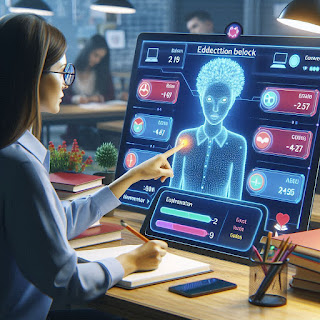Article by: Teacher, Rajabu Mpella (Morogoro - Tanzania)
Introduction
Artificial intelligence (AI) is
reshaping the education sector, offering tools that enhance learning
experiences, automate tasks, and provide personalized education. In classrooms
worldwide, AI supports teachers in lesson planning, grading, and student
engagement, while students benefit from adaptive learning and intelligent
tutoring systems. This transformation has made teaching more efficient and
learning more accessible, setting the stage for a future where technology and
education go hand in hand.
AI’s Role in Teaching
Automated Grading & Assessment
AI-powered systems like Gradescope
and Socrative streamline grading by evaluating assignments and tests
automatically. These tools save teachers hours of work, allowing them to focus
on interactive teaching.
Example: A high school math teacher uses
Gradescope to scan and grade exams. The system identifies errors in students’
problem-solving steps and provides feedback, ensuring fair and consistent
grading.
Personalized Learning Plans
AI can analyze student performance
data and create customized learning pathways to address individual needs.
Platforms like DreamBox and IXL Learning excel in this area.
Example: An elementary school teacher
integrates DreamBox into the classroom. Students struggling with fractions
receive additional interactive lessons, while advanced learners move on to
complex problem-solving tasks.
Smart Content Creation
AI aids teachers in developing
educational content by summarizing lessons, creating quizzes, and generating
practice materials. Tools like ChatGPT, Quillionz and Microsoft
Copilot simplify content preparation.
Example: A science teacher uses Quillionz
to generate multiple-choice questions for a lesson on the water cycle. The AI
tool quickly produces high-quality assessments, freeing the teacher to focus on
instructional delivery.
Virtual Teaching Assistants
AI-powered teaching assistants,
such as Edmentum’s Calypso, address common student queries and offer
additional resources, reducing the workload on teachers.
Example: In a virtual classroom, Edmentum’s Calypso answers students’ questions about upcoming assignments, allowing the teacher to concentrate on live instruction.
AI’s Role in Learning
Adaptive Learning Platforms
AI tracks student progress and
tailors educational content to their strengths and weaknesses. Platforms like Knewton
and Smart Sparrow adapt lessons in real-time to optimize learning
outcomes.
Example: A college student uses Knewton
for an online calculus course. The platform identifies their struggle with
integrals and provides targeted practice problems and video tutorials.
Interactive & Immersive
Learning
By integrating AI with augmented
reality (AR) and virtual reality (VR), educators can create immersive learning
experiences that capture students’ attention.
Example: In a history class, students use
an AI-enhanced VR app to explore ancient Rome. They virtually walk through the
Colosseum and interact with historical figures, making the lesson engaging and
memorable.
Instant Feedback & Assessment
AI tools like Turnitin and Grammarly
offer instant feedback on assignments, helping students improve their work
immediately.
Example: A student submits an essay on
Turnitin. The platform provides instant insights on grammar, originality, and
structure, enabling them to refine their writing before the final submission.
Language Processing Tools
AI-powered language tools assist
students in grammar checks, translations, and writing improvement. Applications
like Google Translate and Grammarly are indispensable in modern
classrooms.
Example: An ESL student uses Grammarly to check grammar and vocabulary in their essay. The tool’s suggestions enhance clarity and accuracy, boosting the student’s confidence.
Advantages of AI for Teachers
- Time-Saving
on Administrative Tasks
AI automates attendance tracking, grading, and scheduling, allowing
teachers to focus on lesson delivery.
Example: A teacher uses an AI-powered
attendance app to record daily attendance automatically, minimizing manual
effort.
- Insights
into Student Performance
AI provides real-time data analytics, enabling teachers to identify and
address learning gaps.
Example: A teacher uses Smart Sparrow’s
dashboard to monitor class performance. Students struggling with a specific
concept receive tailored interventions.
- Dynamic
Lesson Creation
AI helps create interactive and engaging lessons by generating visuals,
videos, and other multimedia content.
Example: A teacher uses Microsoft Copilot
in PowerPoint to design an animated presentation on ecosystems, incorporating
charts and visuals created by AI.
- Classroom
Management
AI-powered tools streamline classroom management by automating routine
tasks.
Example: An AI system tracks student
behavior patterns and alerts the teacher to potential issues, enabling
proactive classroom management.
Advantages of AI for Students
- Personalized
Learning Experiences
AI ensures every student receives tailored instruction based on their
unique needs.
Example: A middle school student using
DreamBox receives customized math problems designed to address their weaknesses
while building on their strengths.
- Enhanced
Accessibility
AI-powered tools provide support for students with disabilities, such as
text-to-speech and speech-to-text capabilities.
Example: A visually impaired student uses
Read&Write to listen to course materials, improving comprehension and
participation.
- Increased
Engagement
Interactive AI tools make learning more enjoyable and engaging.
Example: A gamified learning platform uses
AI to reward students for completing challenges, maintaining their interest and
motivation.
- Immediate
Feedback and Support
Students benefit from real-time feedback, allowing them to correct
mistakes instantly.
Example: A student writing a report on
climate change uses Grammarly to receive instant feedback on sentence structure
and vocabulary, ensuring a polished final draft.
Furthermore, AI is a transformative force in
education, revolutionizing both teaching and learning. By automating routine
tasks, providing personalized learning experiences, and enhancing classroom
engagement, AI empowers teachers and students to achieve their full potential.
The integration of tools like Microsoft Copilot, DreamBox, and Turnitin
demonstrates the vast possibilities AI offers in education. As educators
continue to embrace AI, they pave the way for a more efficient, inclusive, and
innovative educational landscape.










0 Comments